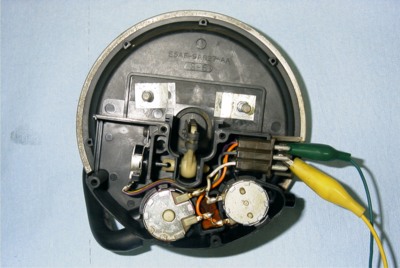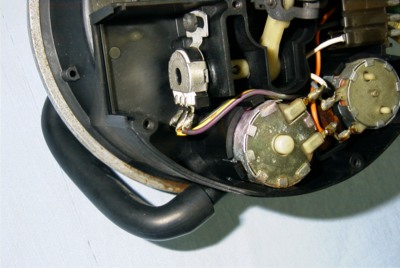Thanks for the info.
I'm currently working on some PLC logic for the governor. Need the tooth count to convert the mag p/u frequency to rpm for use in the start logic and governor.
I'm using a vacuum motor from a cruise control for the motive force on the actuator. Looks like some sort of pulse width modulation is in order to control the internal vacuum / vent solenoids.
[OT] Engineering an electronic governor
Moderators: goglio704, Nissan_Ranger, kassim503
- asavage
- Site Admin
- Posts: 5454
- Joined: 19 years ago
- Location: Oak Harbor, Wash.
- Has thanked: 2 times
- Been thanked: 3 times
- Contact:
Hmmm. What device are you using to monitor up to (99 * 4200 RPM = ) 415Khz? Sounds like a pretty hefty A/D converter. Faced with that, I think I'd use a lower-resolution counter, maybe a single signal per revolution, or quad, or something like that. One fellow made an optical tach for an SD22 that used a single shiny piece of adhesive-backed foil on the flywheel (who was that, Philip? I can't recall.).djekk wrote:I'm currently working on some plc logic for the governor. Need the tooth count to convert the mag p/u frequency to rpm for use in the start logic and governor.
I know that modern FI systems can tell when a cylinder is misfiring by the timing difference between two or three adjacent triggers on the crank sensor, but I assume that tech isn't adaptable by someone like me.
You might be interested in these pics, taken last December:I'm using a vacuum motor from a cruise control for the motive force on the actuator. Looks like some sort of pulse width modulation is in order to control the internal vacuum / vent solenoids.
(click on an image for larger)


This is the back of a pretty std Ford CC servo, circa 1989, as used on many of the corporate rigs. This particular one is from my Aerostar, but the Taurus/Sable/etc servos are all very similar. The two lower cans are the vac solenoids (one inlet, one dump). The pot on the left side is a linear taper pot that provides the controller with arm angle feedback.
For a couple of winters, I was having some mild surging on my morning commute using the CC. This past winter it was worse, so I made it a priority to track it down. I was thinking in terms of high friction in the cable from the servo to the throttle body, but it turned out to be a crappy pot. Dead spots. A bit of tuner cleaner followed by a dousing with TriFlow, and it's been working better than it ever has in the years I've owned it.
Anyway -- a feedback pot could be very useful if you're using a PLC and your ladder logic needs to know just how far you've pulled the accelerator. These old Ford CC servos can be had for practically nothing these days, and the back unscrews very nicely. Servo diaphragm diameter is around 5" so they operate on pretty low vacuum supply conditions just fine.
OT stuff:
I have just a little PLC experience with the AB 17xx line, none with Fanuc stuff. I got called in to finish a reasonably complex custom cheese derinding machine for Nestle about 13 years ago. The only thing that I had to do was to write the program to control it (I had zero PLC experience up to that point, good thing Consolidated Electric Distributors had a patient outside Sales Rep!), and also write & document both the machine electrical schematic and wiring diagram -- for four motors, nine prox sensors, assorted telltales and emergency shutoffs, and a bunch of pneumatic control solenoids, as well as the usual contactors and operator controls. For me, it was somewhat . . . daunting. To my credit, I had only one wiring misteak in the whole mess -- I didn't have to do the wiring myself, we had a professional do that, and he was damned sharp, found my wiring misteak in about 30 seconds, and I had a LOT of lines on that drawing, I can tell you.
The cheese derinder did seem to derind cheese wheels pretty well. If the safety covers were off, the prototype would also launch them 30' -- the pneumatic infeed never worked right, and got replaced by a chain-drive carriage, but I'll never forget the sight of a 40 lb ($400) Parmesan cheese wheel shooting out and across the shop!
After working with ladder logic, I though it was the nuttiest thing since RPG, and I liked RPG
Regards,
Al S.
1982 Maxima diesel wagon, 2nd & 4th owner, 165k miles, rusty & burgundy/grey. Purchased 1996, SOLD 16Feb10
1983 Maxima diesel wagon, 199k miles, rusty, light yellow/light brown. SOLD 14Jul07
1981 720 SD22 (scrapped 04Sep07)
1983 Sentra CD17, 255k, bought 06Jul08, gave it away 22Jun10.
Al S.
1982 Maxima diesel wagon, 2nd & 4th owner, 165k miles, rusty & burgundy/grey. Purchased 1996, SOLD 16Feb10
1983 Maxima diesel wagon, 199k miles, rusty, light yellow/light brown. SOLD 14Jul07
1981 720 SD22 (scrapped 04Sep07)
1983 Sentra CD17, 255k, bought 06Jul08, gave it away 22Jun10.
-
djekk
- Posts: 7
- Joined: 19 years ago
Divide that rpm by 60 and we have a much more reasonable 6,930hz. I've got some 'legacy' AB1771 stuff. A QRC card will have no trouble with the required frequency ranges.
That servo is identical to mine, which I pulled off of a '91 Tbird.
Ladder logic seems to be easier for people who have been staring at relay schematics to pick up. It works OK for discrete I/O.
That servo is identical to mine, which I pulled off of a '91 Tbird.
Ladder logic seems to be easier for people who have been staring at relay schematics to pick up. It works OK for discrete I/O.
- asavage
- Site Admin
- Posts: 5454
- Joined: 19 years ago
- Location: Oak Harbor, Wash.
- Has thanked: 2 times
- Been thanked: 3 times
- Contact:
OK . . . bear with me, I'm not following that . . . are you going to sense only every 60th tooth?djekk wrote:Divide that rpm by 60 and we have a much more reasonable 6,930hz.
1771 I recognize -- that's what I've used -- but "QRC" I don't, and Google is not being my friend. Could you expand on what the QRC module is/does?I've got some 'legacy' AB1771 stuff. A QRC card will have no trouble with the required frequency ranges.
Yeah, I suppose so. What you are used to is what is easiestLadder logic seems to be easier for people who have been staring at relay schematics to pick up. It works OK for discrete I/O.
Regards,
Al S.
1982 Maxima diesel wagon, 2nd & 4th owner, 165k miles, rusty & burgundy/grey. Purchased 1996, SOLD 16Feb10
1983 Maxima diesel wagon, 199k miles, rusty, light yellow/light brown. SOLD 14Jul07
1981 720 SD22 (scrapped 04Sep07)
1983 Sentra CD17, 255k, bought 06Jul08, gave it away 22Jun10.
Al S.
1982 Maxima diesel wagon, 2nd & 4th owner, 165k miles, rusty & burgundy/grey. Purchased 1996, SOLD 16Feb10
1983 Maxima diesel wagon, 199k miles, rusty, light yellow/light brown. SOLD 14Jul07
1981 720 SD22 (scrapped 04Sep07)
1983 Sentra CD17, 255k, bought 06Jul08, gave it away 22Jun10.
- asavage
- Site Admin
- Posts: 5454
- Joined: 19 years ago
- Location: Oak Harbor, Wash.
- Has thanked: 2 times
- Been thanked: 3 times
- Contact:
Thanks for the math lessondjekk wrote:At 4200 rpm the engine 1X frequency is 70 hertz.
The 1771 QRC is a very old card that the 1771 CFM replaced.
Um . . . if I Google on 1771 CFM, will a site tell me what it does? I guess I've gotten lazy -- toting hay around does that to me. Phuuttt . . . hay stuck in my throat
Regards,
Al S.
1982 Maxima diesel wagon, 2nd & 4th owner, 165k miles, rusty & burgundy/grey. Purchased 1996, SOLD 16Feb10
1983 Maxima diesel wagon, 199k miles, rusty, light yellow/light brown. SOLD 14Jul07
1981 720 SD22 (scrapped 04Sep07)
1983 Sentra CD17, 255k, bought 06Jul08, gave it away 22Jun10.
Al S.
1982 Maxima diesel wagon, 2nd & 4th owner, 165k miles, rusty & burgundy/grey. Purchased 1996, SOLD 16Feb10
1983 Maxima diesel wagon, 199k miles, rusty, light yellow/light brown. SOLD 14Jul07
1981 720 SD22 (scrapped 04Sep07)
1983 Sentra CD17, 255k, bought 06Jul08, gave it away 22Jun10.
Who is online
Users browsing this forum: No registered users and 1 guest